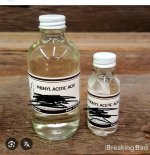- Language
- 🇺🇸
- Joined
- Jul 3, 2023
- Messages
- 5
- Reaction score
- 3
- Points
- 3
So I found something extremely strange and surprising. I feel it has to be a mistake, but there’s a tractor supply vendor that I found that is selling a self branded product called phenylacetic acid.
see picture. Attempted to blur out the company name but I’m sure anyone can find it.
I ordered some and can confirm it even has the honey smell.
What are the chances of this being real ? Any easy way to test it ?
edit - just goes to show how little I know of this topic, but I just realized PAA is a solid not a liquid. I wonder why they named it this ?
see picture. Attempted to blur out the company name but I’m sure anyone can find it.
I ordered some and can confirm it even has the honey smell.
What are the chances of this being real ? Any easy way to test it ?
edit - just goes to show how little I know of this topic, but I just realized PAA is a solid not a liquid. I wonder why they named it this ?

